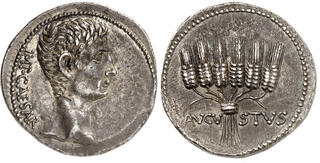Lot description:
Auguste (27-14)
Cistophore en argent - Pergame ou Ephèse ? (27-26)
D'une qualité exceptionnelle.
Magnifique patine médaillier.
Un des plus beaux exemplaires connus, du meilleur style.
Exemplaire de la collection U.N. (selon Kent & Hirmer), et de la vente NAC 59 du 4 avril 2011, N° 873 et de la vente Palombo 19 du 12 décembre 2020, N°83.
Cet exemplaire publié dans : J. P. C. Kent, B. Overbeck, A. U. Stylow, M. Hirmer et A. Hirmer, Die römische Münze, Munich 1973, pp. 95-96, pl. 35, N° 137, et dans J. P. C. Kent, M. Hirmer et A. Hirmer, Roman Coins, Londres 1978, p. 277, pl. 37, N° 130.
Seulement 22 exemplaires connus des auteurs du Roman Provincial Coinage.
11.91g - RPC I 2212 - BMC 699 - RIC 494 - CBN 955a
Superbe à FDC – (photo grade) Choice AU (5/5 et 3/5) Fine style - Flan flaw
The Res Gestae Divi Augusti ('the achievements of the deified Augustus'), inscribed on two columns near his Mausoleum in Rome, the text of which has survived as an inscription in the Temple of Roma and Augustus in Ancyra (Ankara), tells us that he was proud to have " freed the sea from pirates". Indeed, the wheat illustrated on the reverse of this coin was cultivated in the entire Roman empire, but especially south of the Mediterranean and notably in Egypt. At times of political unrest, Rome was always at risk of food shortages, and as grain was a key element of the Roman diet, one of Augustus' greatest achievements was his defeat of piracy which was critical for the successful shipment of grain to Rome. On this coin, therefore, the new emperor celebrates his ability to feed the people, following his reduction of the Ptolemaic Kingdom of Egypt to a Roman province, having invaded Egypt in August 30 BC after the battle of Actium and the death of Marc Antony and Cleopatra. Cistophori had been struck by the Attalid kings of Pergamon in the 190s BC, and later by the governors of Roman Asia (after the bequest of the kingdom to Rome in 133 BC). The first issues had depicted a cista mystica (a sacred basket containing serpents), which gave the name to these coins. In order to satisfy the local population of western Anatolia - which continued to use them until the 3rd century AD - Augustus continued to strike a number of these large and heavy silver coins (and many of Augustus's cistophori were used as flans for the strike of tetradrachms under Hadrian), with his own portrait on the obverse. It is unconfirmed that they were ever used in the Western empire, thought their weight, if one allows for some imprecision, was both that of 4 drachms and of 3 denarii.
Estimate: CHF 70'000 |  |